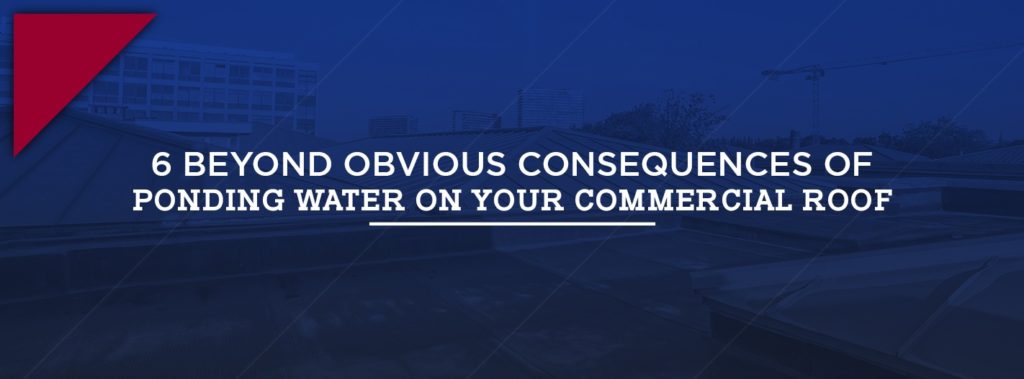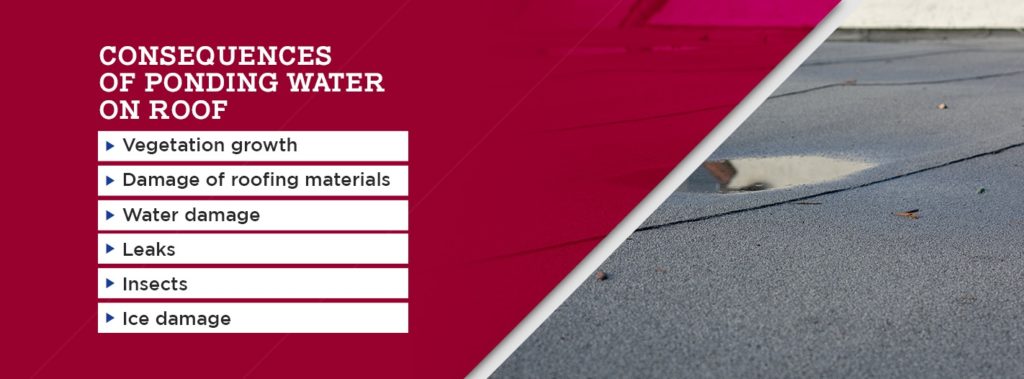
Table of Contents
- How Much Water Is Too Much Water?
- What Causes Ponding?
- Consequences of Ponding Water on Roof
- How to Fix and Prevent Ponding Water on Flat Roof
- Contact David Maines for Commercial Roofing Service
As a business owner, you know how important your building is. You spend time, money and effort keeping your building in great shape to provide goods and services to your customers. It’s no surprise, then, that one of the most important parts of your building is the roof.
If your business building has a flat roof, you could be at risk of ponding water. This can lead to visible signs of damage, requiring extensive and costly repairs. The experts at David Maines & Associates, Inc. have developed this guide so you can better understand the consequences of water pooling on your roof. We’ve even included some tips on how to fix and prevent ponding water to keep your roof in great shape for years to come.
How Much Water Is Too Much Water?
How much ponding is acceptable on a flat roof? Roofs, by nature, can handle a bit of water. Standard sloped roofs dispose of water by letting gravity do all the work. The water leaves the roofs, enters the drains and flows away. How do flat roofs, then, dispose of water after rainstorms or melting snow? You may think some standing water on flat roofs is normal, but this is actually far from the truth.
Even flat roofs have a slight slope to them, allowing water to enter nearby drains and gutters. If you notice water standing on your roof for more than a couple of days, then you know you have a problem. At this point, you should call the professionals at David Maines to take a look. You could have an issue that, if left unresolved, could lead to some serious problems.
What Causes Ponding?
Several factors can contribute to water pooling on your roof, starting with the roof’s pitch. If your business’s flat roof lacks the proper pitch, or slope, of 1/4 inch per foot, water may be unable to run off. There could also be leaves, twigs, dirt or other debris in your gutters and drainage system. If this is the case, the water on your roof will have nowhere to go, causing ponding.
There could be too much roofing material or improper flashing on your roof’s edge. This creates a slight increase in height at the edge of the roof, trapping water before it can run off. Water pooling on your roof can result from any of these issues, so you should call a professional to uncover the main cause. If not, your business’s roof could face severe and obvious consequences.

Consequences of Ponding Water on Roof
Before long, the consequences of ponding water on your flat roof will start revealing themselves. If you’re unsure if your roof has a ponding issue, these signs will let you know right away that you do. When you see any of these results of ponding water, you must take action right away to solve the issue. Otherwise, you could face costly damage repairs.
Here are six obvious consequences of ponding water on your commercial roof:
- Vegetation growth: It’s true — ponding water can lead to plants growing on your roof. The pools of water on your roof can collect dirt particles floating through the air. This dirt can accumulate, creating the perfect environment for plants to take root. The moisture and dirt can foster saplings from nearby trees, grass, weeds, algae and even mold. These plants can damage your roof, and their weight is a risk to structural collapse. Mold and mildew even present a health risk to you and your employees.
- Damage of roofing materials: Water pooling on your business roof acts as a magnifying glass for the sun. This will amplify the sun’s harmful ultraviolet rays striking your rooftop. Your roof can then experience premature breakdown from the sun in the area with the ponding water. You may need to repair or replace that section of the roof.
- Water damage: Ponding water can lead to severe water damage to your roof and building interior. Water damage from ponding water may be the most obvious consequence on this list, but consider the extent of the damage. Ponding water is heavy, which can lead to a sagging roof. This will attract more water to flow to the area, compounding the issue. The structural damage to your roof will get worse, leading to even more problems.
- Leaks: As more and more water accumulates on your roof, it’s only a matter of time before it makes its way inside. Water will decompose your roofing materials, allowing water to enter your building from above. This can result in leaks and water damage to your ceilings and walls. Moisture in your building’s interior can cause mold growth, which is a health hazard for everyone inside your building.
- Insects: Bugs, flies, mosquitos and various insects make their habitats in areas of warm, standing water. Ponding water on your roof during the spring and summer can provide the perfect environment for pests to multiply. This will be a nuisance to you and your employees, but it could also affect nearby businesses and homes. Insects can even harbor diseases, risking the community’s health.
- Ice damage: As snow melts throughout the winter, water can start pooling on your flat roof. When the temperatures drop, that water can freeze, resulting in structural damage to your roof. The freeze-thaw cycle can create cracks and visible damage to your roof as the water expands and contracts. If you have a ponding water problem, you should consider taking care of it before winter hits.
How to Fix and Prevent Ponding Water on Flat Roof
You should seek to fix your ponding water problem to avoid costly repairs and even health risks. Here are some ways you can fix and prevent ponding water on your roof:
- Unclog gutters and drains: In the best-case scenario, your ponding water issue results from clogged gutters and drains. Clear out any debris from these structures and see if that resolves the issue.
- Add more drains: If your area is prone to heavy rainfall, your flat roof may be unable to handle the sheer volume of water it receives. You may need to add some more drains to your roof to direct the water from your roof and away from your building.
- Add slopes: An improper slope may cause ponding water. That’s why fixing low spots on flat roofs is an essential remedy. Add some material to your roof that can create an artificial slope and direct water from lower areas to your drains and gutters.
- Schedule yearly maintenance: To make sure your roof stays in great shape, you might need to pay a little more attention to it. Schedule yearly maintenance to make sure your roof is ready for the coming rain and snow.
- Hire a professional: For these and other fixes, you may need professional help. Roof work can be dangerous, and faulty fixes can create more problems. Seek professional help from an expert roofing company to get the job done right the first time.
Contact David Maines for Commercial Roofing Service
David Maines & Associates, Inc. is your best choice for fixing your roof’s ponding water issue. Since 1989, we have provided excellent commercial roofing services in communities throughout Pennsylvania. Thanks to our high-quality service, we’ve expanded into the surrounding areas. Now we can offer our professional roofing services to Ohio, Virginia, West Virginia, Maryland, Delaware, New Jersey and New York.
When you need to fix your ponding water problem or any other roofing issue, David Maines is the company you can trust. Contact us today to learn more. We look forward to serving you!
Share
